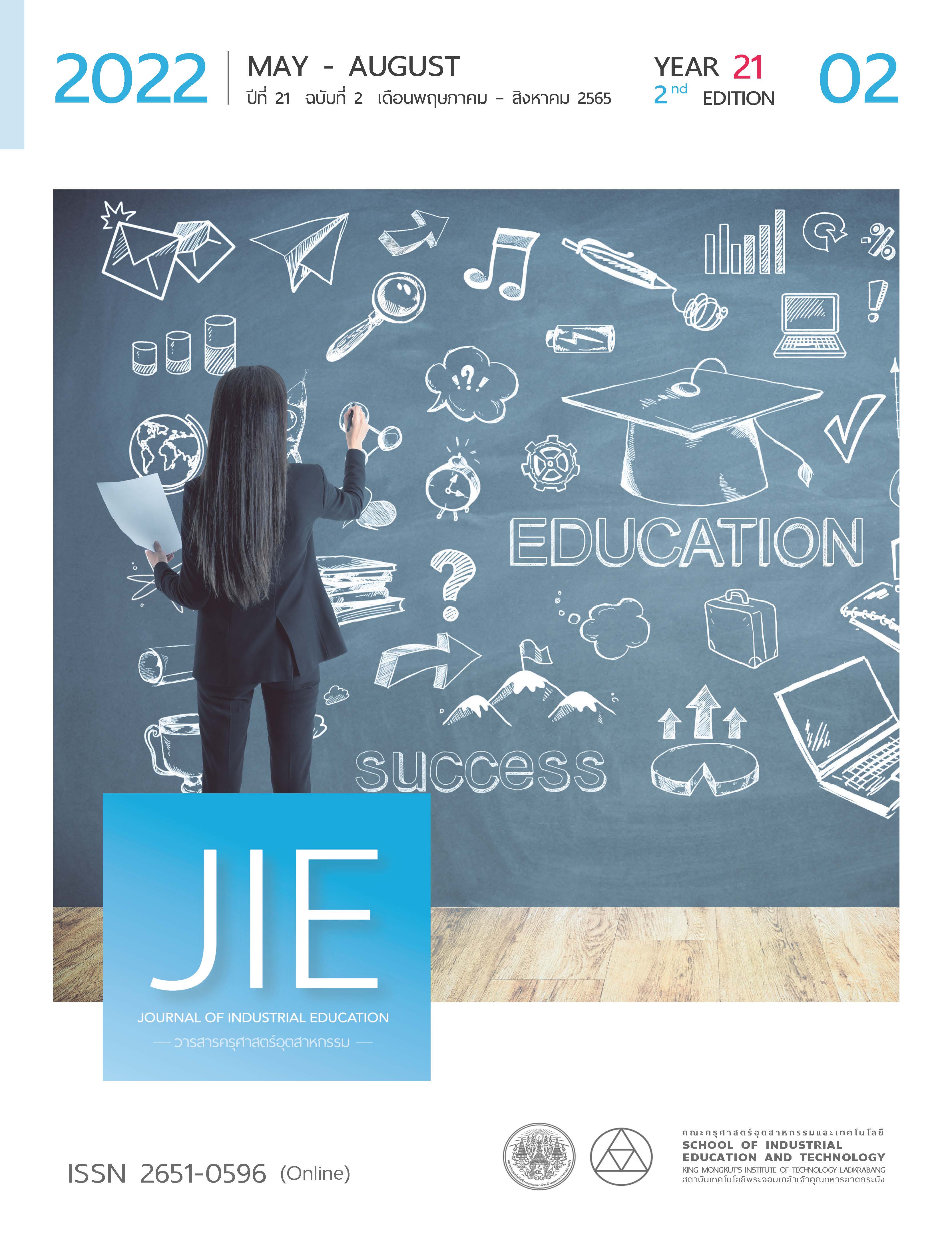การศึกษาแนวทางการจัดการเรียนรู้แบบห้องเรียนกลับด้านร่วมกับ งานทางคณิตศาสตร์เพื่อส่งเสริมการรู้ทางสถิติของนักเรียนชั้นมัธยมศึกษาปีที่ 2
คำสำคัญ:
การรู้ทางสถิติ, การจัดการเรียนรู้แบบห้องเรียนกลับด้าน, งานทางคณิตศาสตร์บทคัดย่อ
วิธีการจัดการเรียนรู้มีความสำคัญต่อการพัฒนาทางวิชาการ การศึกษานี้ได้ค้นพบแนวทางการจัดการเรียนรู้แบบห้องเรียนกลับด้านร่วมกับงานทางคณิตศาสตร์ที่ส่งเสริมการรู้ทางสถิติของนักเรียนหลังจากการเรียนรู้ โดยมีผู้เข้าร่วมการวิจัย คือ นักเรียน
ชั้นมัธยมศึกษาปีที่ 2 ของโรงเรียนมัธยมศึกษาขนาดใหญ่ประจำอำเภอแห่งหนึ่ง ในจังหวัดอุทัยธานี จำนวน 32 คน ในภาคเรียน
ที่ 2 ปีการศึกษา 2564 ที่ได้รับการคัดเลือกแบบเจาะจง (Purposive sampling) ซึ่งมีเครื่องมือที่ใช้ในการวิจัย ได้แก่
แผนการจัดการเรียนรู้จำนวน 3 แผน แบบสะท้อนผลการจัดการเรียนรู้ ใบกิจกรรม แบบวัดการรู้ทางสถิติก่อนเรียน และ
แบบวัดการรู้ทางสถิติหลังเรียน ส่วนการศึกษาครั้งนี้ใช้รูปแบบการวิจัยเชิงปฏิบัติการในชั้นเรียนจำนวน 3 วงจรปฏิบัติการ
ในระยะเวลาทั้งหมด 12 ชั่วโมง และวิเคราะห์ข้อมูลด้วยการวิเคราะห์ข้อมูลเชิงคุณภาพจากการวิเคราะห์เชิงเนื้อหา
(Content analysis) โดยใช้การตรวจสอบสามเส้าด้านแหล่งข้อมูล (Resource triangulation) การตรวจสอบสามเส้าด้านวิธีการรวบรวมข้อมูล (Methodological triangulation) การวิจัยครั้งนี้สามารถสรุปแนวทางการจัดการเรียนรู้แบบห้องเรียนกลับด้านร่วมกับงานทางคณิตศาสตร์ ได้ 5 แนวทาง ประกอบด้วย (1) แนวทางการจัดกิจกรรมการเรียนรู้นอกห้องเรียน (2) แนวทาง
การตรวจสอบความรู้จากนอกห้องเรียน (3) บทบาทของครูในการจัดการเรียนรู้แบบห้องเรียนกลับด้าน (4) แนวทางการใช้งานทางคณิตศาสตร์เพื่อส่งเสริมการรู้ทางสถิติในชั้นเรียน และ (5) แนวทางการประเมินผลสิ่งที่ได้เรียนรู้ นอกจากนี้ผลการเปรียบเทียบระดับการรู้ทางสถิติของนักเรียนจากแบบวัดการรู้ทางสถิติหลังเรียนสูงกว่าก่อนเรียน และพบว่า นักเรียนสรุปข้อมูลอยู่ในระดับ 3
การสรุปข้อมูลทางสถิติแต่ไม่สมเหตุสมผล (Inconsistent) ซึ่งสามารถใช้แนวคิดค่ากลางตัดสินข้อมูลได้แต่ยังสรุปข้อมูลด้วยเหตุผลที่ไม่สมเหตุสมผล และระดับ 4 การสรุปข้อมูลทางสถิติอย่างง่าย (Consistent-non critical) ที่สามารถใช้คณิตศาสตร์ร่วมสรุปข้อมูลในสถานการณ์ที่ไม่ซับซ้อนอย่างมีวิจารณญาณและหาค่ากลางของข้อมูลได้แต่ไม่ตระหนักถึงค่าที่ผิดปกติ
เอกสารอ้างอิง
Ben-Zvi, D., & Garfield, J. B. (Eds.). (2004). The challenge of developing statistical literacy, reasoning and thinking. Kluwer Academic.
Bergmann, J., & Sams, A. (2012). Flip your classroom: Reach every student in every class every day. International society for technology in education.
Boonrid, P., & Sumirattana S. (2019). A study of mathematics learning achievement and geometric thinking on circular of Mathayomsuksa 3 students learning by using the Geometer’s Sketchpad Program (GSP) with concept of flipped classroom activities. Journal of Industrial Education, 18(1), 109–118. (in Thai)
Çatman Aksoy, E., & Işıksal Bostan, M. (2021). Seventh graders’ statistical literacy: An investigation on bar and line graphs. International Journal of Science and Mathematics Education, 19(2), 397-418.
Duangtod, Y. & Jermtaison, R. (2019). The learning management by using flipped classroom for efficiency of studying development applied in mathematics subject for junior high school grade 3 students. Veridian E-Journal, Silpakorn University (Humanities, Social Sciences and Arts), 12(2), 341-358. (in Thai)
Emoch, N., & Nopparit, T. (2018). Learning provision through real life information to promote statistical literacy of grade 11 students. In V. Sooksatra (Ed.), Rangsit Graduate Research Conference: RGRC (pp. 1893-1901). (in Thai)
Gal, I. (2004). Statistical literacy. In D. Ben-Zvi & J. Garfield (Eds.), The challenge of developing statistical literacy, reasoning and thinking (pp. 47-78). Springer.
Henningsen, M., & Stein, M. K. (1997). Mathematical tasks and student cognition: Classroom-based factors that support and inhibit high-level mathematical thinking and reasoning. Journal for Research in Mathematics Education, 28(5), 524-549.
Hongngern, K., & Nopparit, T. (2020). Using realistic mathematics education approach to promote statistical literacy: Knowledge aspect of Grade 11 students. In V. Sooksatra (Ed.), Rangsit Graduate Research Conference: RGRC (pp. 1839-1846). RGRC (in Thai)
Institute for the Promotion of Teaching Science and Technology (IPST). (2017). The manual of mathematics curriculum. Agriculture Cooperative of Thailand. (in Thai)
Khan, R. N., & Watson, R. (2018). The flipped classroom with tutor support: an experience in a level one statistics unit. Journal of University Teaching & Learning Practice, 15(3), 2-21
Kuankeaw, P. & Nopparit, T. (2015). Effect of using flip classroom and case-based learning for enhancing statistical thinking of students in higher education. Journal of Humanities and Social Sciences University of Phayao, (3)1, 16-30. (in Thai)
Metpattarahiran, C. (2017). Flipped classroom and mathematics teaching. IPST Magazine. 46(209), 20-22. (in Thai)
Ministry of Education. (2017). Indicators and learning standards, learning area of mathematics the basic education core curriculum B.E. 2551 (A.D. 2008). Agricultural Cooperative Federation of Thailand. (in Thai)
Murray, S. & Gal, I. (2002). Preparing for diversity in statistics literacy: Institutional implications. http://iase-
web.org/documents/papers/icots7/6C1_WATS.pdf
National Institute of Educational Testing Service (NIETS). (2021). Results of Ordinary National Educational Test (O-NET) of Grade 9 students in semester 2020. https://www.niets.or.th/th/content/view/18625 (in Thai)
Naewdong, T., Nualpang, K., & Treepaiboon, K. (2018). The effects of inductive learning management and think - pair – share technique on mathematical concept and reasoning ability of Mathayomsuksa 2 students. Journal of Humanities and Social Sciences Surin Rajabhat University, 20(1), 29-41. (in Thai)
Moothummachai, N. & Kamol, N. (2017). Promoting mathematical reasoning abilities by using mathematical tasks: Classroom action research. Journal of Education Naresuan University, 22(2), 135-146. (in Thai)
Palee, P., & Kamol N. (2020). Classroom action research for promoting statistical thinking of Grade 7 students by using the five practices. Journal of Education Research Faculty of Education, Srinakharinwirot University, 15(2), 105-117. (in Thai)
Panich, V. (2013). Teacher teaching flipped classroom for students (2nd ed). The Siam Commercial Foundation. (in Thai)
Sukharee, S. (2021). The development of an instructional model according to flipped classroom concept with active learning to enhance mathematical problem solving and critical thinking abilities of Tenth Grade students. Journal of Educational Technology and Communications Faculty of Education Mahasarakham University, 4 (11), 68-85. (in Thai)
Stein, M. K., & Smith, M. S. (1998). Mathematical tasks as a framework for reflection: From research to practice. Mathematics Teaching in the Middle School, 3(4), 268-275.
Watson, J., & Callingham, R. (2003). Statistical literacy: A complex hierarchical construct. Statistics Education Research Journal, 2(2), 3-46.
Watson, J. M. (2003). Statistical literacy at the school level: What should students know and do. The Bulletin of The International Statistical Institute, Berlim, 54, 1-4.
ดาวน์โหลด
เผยแพร่แล้ว
รูปแบบการอ้างอิง
ฉบับ
ประเภทบทความ
สัญญาอนุญาต
ลิขสิทธิ์ (c) 2022 วารสารครุศาสตร์อุตสาหกรรม

อนุญาตภายใต้เงื่อนไข Creative Commons Attribution-NonCommercial-NoDerivatives 4.0 International License.
"ข้อคิดเห็น เนื้อหา รวมทั้งการใช้ภาษาในบทความถือเป็นความรับผิดชอบของผู้เขียน"



